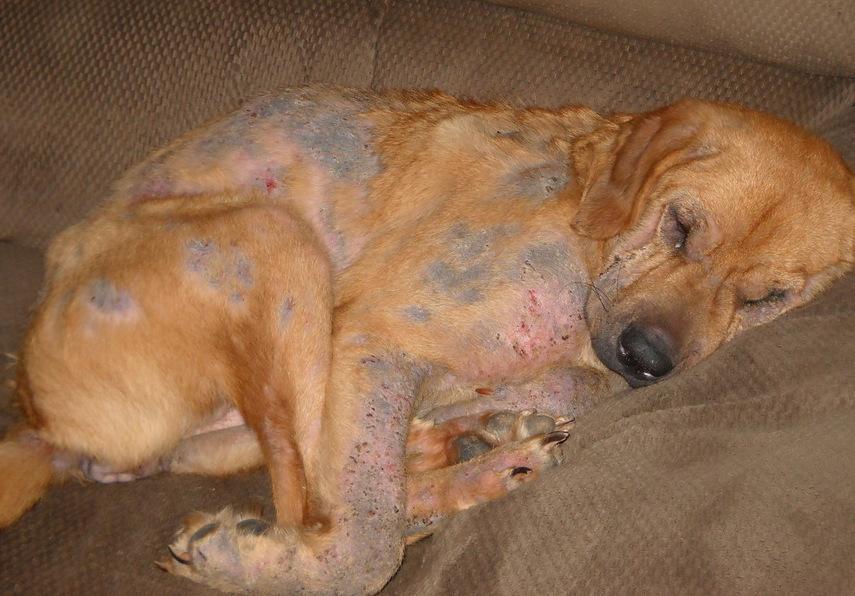Scabies in Dogs



See files for Dogs
Owners or prospective dog owners will be interested to know everything about mange in dogs, its symptoms and treatment and even some home remedies. Scabies is a skin disease caused by several types of mites and can have serious consequences if not treated properly. It is found all over the planet and affects numerous animal species. Generally, it occurs by direct contagion with some other affected animal or with objects that have been in contact with it.
Therefore, as soon as we detect symptoms in our dog, go to your vet to diagnose what type of mange it is and treat it as soon as possible. Keep reading this AnimalWised article and discover the symptoms and treatment of scabies in dogs.
Types of scabies in dogs and the parasites that produce them
Scabies is a dermatological infection caused by ectoparasites, specifically by mites. According to the type of mite that causes this pathology we will have one type of mange or another and, therefore, a specific treatment. When our mites are infested by these mites, they are lodged in their skin and fur. They quickly begin to feed on the skin, sebum and keratin, proliferating at high speed. Due to this infestation in the skin, the dog suffers a great itch that causes them to scratch and rub against almost everything until they produce wounds. The early detection of symptoms is very important, as this will avoid the spread to other pets and the severity of the particular case.
Mites are microscopic ectoparasites, like little spiders found in animals and part of a normal ecosystem plants. There are many different types and each type can produce different diseases and problems in some animals.
As we have said, there are various types of scabies that affect dogs, caused by different types of mites and their treatment is more or less easy depending on the origin and time of the process in which we start treatment and cures. We must keep in mind that scabies are perfectly treatable, although very annoying and cumbersome for those who suffer from them. However, if adequate treatment is not carried out, infections and secondary diseases can occur and even the death of the animal.
The following is a classification of the most common types of scabies in canines:
- Demodectic Scabies: This is one of the most common scabies in dogs. It is also known as red mange, demodectic mange or demodicosis and is produced by the Demodex canis mite. This mite lives normally on the skin of our dog, but when their defenses drop a lot this mite reproduces wildly and develops the disease. It occurs very frequently in dogs with a poor immune system, that is, with very low defenses. In addition, another of the most common forms in which this type of scabies appears is during childbirth; When the mother gives birth it is passed to her puppies. Sometimes, if it is very mild, the problem can be referred only with a recovery of the animal's defenses by providing a good diet. There are several types of demodectic mange:
- Localized demodectic scabies: It usually occurs mainly on the head, especially on the face and ears. Localized scabies are more common in puppies under one year of age and will generally disappear after a short time. The first symptoms are loss of hair around the eyes and mouth. If it occurs in other parts of the body, baldness will appear on the legs, feet and their back may reach three centimeters in diameter.
- Generalized demodectic mange: This level of demodectic mange may begin to be considered when five or more bald spots are present on the body of the affected dog. In addition, large areas may be completely hairless.
- Demodectic Pododermatitis: This is the most resistant form of demodectic mange, difficult to diagnose and treat. It appears only on the legs and always involves bacterial infections, which give off an unpleasant smell.
- Sarcoptic mange: It is the most common mange in dogs, even more so than the demodectic mange and in fact it is also known as canine mange. The mite that produces it is called Sarcoptes scabiei and, therefore, this type of scab is also identified as scabies. This mite reproduces at high speed and is not part of the environment of our dog's skin. It is highly contagious, its contagion occurs by contact and can also affect humans. Therefore we must handle animals infested with latex gloves. Symptoms usually begin to show up after a week of transmission. This scab is the one that produces a greater uncontrolled itching, which can lead us to think at the beginning of an erroneous way that it is a flea infestation. The ideal is to detect it as soon as possible to prevent it from spreading and worsening, since it will then be more resistant to treatment.
- Otodectic Scabies: This scab is produced by the Otodectes cynotis mite and is more common in cats than in dogs. It is spread by direct contact and affects the ears of our pets. In addition to the usual clinical signs in scabies, this results in secondary otitis to the animal. These mites are visible inside the ear and if we observe carefully we see white moving points.
- Cheyletiella scabies: Also known as cheiletielosis or walking dandruff. This scab is produced by the mite Cheyletiella spp. Although it is more common in cats, it is highly contagious between dogs and especially in puppies. It can be transmitted to humans producing a red and irregular rash.
- Pneumonyssoides scabies: The mite responsible is called Pneumonyssoides caninum and is found on the nose of dogs and other carnivores. It is not very frequent and usually does not cause serious symptoms. In case of massive infestations it can cause chronic sneezing, nose bleeds and nasal secretions. It is transmitted from one dog to another by nose contact.

Contagion - where do dog scabies come from?
There are several forms of contagion which can lead our dog to catch scabies. For example, when there is a significant drop in their defenses, the usual mites on dogs' skin take advantage of the opportunity and spread wildly. Another way is during labor and lactation of puppies in case the mother is infested. Finally, the contagion by contact in any canine specimen is the one we usually see more often. In case the animal is healthy and strong, the odds of contracting this pathology are lower, but we will see it often in already sick and undernourished individuals with low defenses. The contact can occur between dogs or with objects and places infested with mites where an animal has been with this parasitic disease.
There are factors that make our pet more prone to scabies, such as lack of hygiene, an unhealthy environment, poor health that leads to low defenses, malnutrition, constant contact with many dogs outside, among others.
In the case of demodectic mange, there is a greater propensity in specimens of short hair and in some breeds such as the beagle, dalmatian, daschund, doberman, boxer, bulldog, pointer, shar pei and terriers.

Symptoms and detection of scabies in dogs
To detect scabies we must look at several symptoms that are presented, which fortunately, are fairly specific symptoms of this type of skin condition and immediately catch our attention. The most common symptoms are:
- Itching and burning of the skin
- Redness and inflammation of the skin
- Constant scraping
- Rubbed against objects for relief
- They stop eating (anorexia)
- Quick weight loss
- Loss and weakening of hair with areas completely without fur
- Skin rashes (red spots)
- Skin scales
- Wounds and sores on the skin
- Bad odor of the skin
- Dry, crusty and thick skin in the most advanced stages of scabies
If we detect some of these symptoms in our pet we must act quickly to avoid the spread of the condition. Although we can alleviate symptoms with some remedies that we will see later, it is vital that we go to the vet and follow the appropriate treatment for each type of scabies.

Prevention and treatment for scabies in dogs
As they say, better safe than sorry. The most effective way to combat scabies is to prevent it, although we also know that this skin disease can be cured with proper treatment and care. But it is a slow process that causes our pet to suffer from extremely annoying symptoms.
As prevention measures we will follow the following guidelines:
- We will maintain good daily hygiene of our faithful friend, in addition to providing them with monthly baths with a suitable shampoo and daily brushing.
- We will also maintain the cleanliness of their environment.
- We will avoid contact with animals that may be infected by mange and, if you suspect that your pet suffers from it, we will also avoid contact with others so that it does not transmit it to others.
- We will respect the schedule of veterinary checks, deworming (external with pipettes and internal with pills) and vaccination. This will give an early detection of the problem and prevent infestations and diseases that may weaken our canine and make them more prone to scabies.
- It is very important to prevent the recurrence of scabies, which is very easy, to extend the treatment as much as possible and to go through several vet check ups until you can confirm that the problem has disappeared.
- We will also treat all other animals that may have been in contact and disinfect all things such as blankets, beds, necklaces, feeders, drinking fountains, among other objects that have been in contact with the sick dog.
- We will provide adequate and healthy food to our dog so that they are strong and so is their immune system.
- To avoid otodectic mange we must provide good care and hygiene of our pet's ears.
If prevention is not enough and our furry companion ends up showing symptoms of scabies, we should go to the vet as soon as possible so that he or she can diagnose whether or not this disease should be treated, and what is the best solution. The treatment to follow will not only depend on the type of mange that our pet suffers, but also depend on breed and age, among other factors.
The treatment that the specialist will prescribe to us may be mainly drugs that are an oral, topical or injectable acaricide. Generally with ivermectin, selamectin, moxidectin and milbemycin oxime. In addition, we will provide analgesics, anti-inflammatories, shampoos or bath powders with skin-relieving and acaricidal products and some more specific medication for a secondary skin problem such as bacterial or antibiotic infection or fungicide. In case of otodectic scabies the acaricide medicine will be one of special topical use for the ears and we will administer it to our dog by dropping a few drops on the ears and massaging it to penetrate. It will be of vital importance that, whatever mange it may be, to do the complete treatment every day for as long as the veterinarian tells us. Never finish it before even if the dog seems to be cured. If we withdraw the treatment prematurely because it seems to us that the problem has already passed, chances are that in a few days or weeks the scabies will reappear, since the few mites that may have remained will recover and proliferate again.

Home remedies for scabies in dogs
There are no home remedies to cure scabies, but there are remedies to alleviate the symptoms, that will help our pet to overcome the process. Before proceeding with any of them it will be convenient to consult with our vet of confidence to discover the most convenient remedies in the case of our dog. Here are a number of home remedies that help complete the veterinary treatment:
- Baths: Baths are vital to the treatment and to relieve the excessive itching that our pet endures. We can bathe our dog suffering from scabies every week or two with a white, neutral soap and/or acaricide prescribed by the vet. Use warm water and rub very gently. We must leave the soap to act for a few minutes before rinsing it and ensure our dog does not lick it. We will have to use latex gloves whenever we move our sick pet. We will never brush them, but with our hands, gently massage their fur and skin. Let them dry naturally or pat dry with a soft towel and never rub their skin with the towel.
- Adequate diet and vitamin supplements: A positive change to our dog's diet along with vitamins, will help regain strength of their immune system, being able to combat mites and helping to eradicate scabies.
- Raw food: It is very good during the scabies process that the dog eats raw food like vegetables and herbs. The most suitable are kyolic garlic, cat's claw and olive oil extract. We will chop the vegetables very small so they can consume more easily.
- Furry friend: It may seem strange, but a dog and who feels loved and accompanied, will be a happier dog and therefore will be more easily cured than a sad and depressed dog.
- Oils: Olive oil can help weaken deposits of mites and eliminate the weak. In addition, you can combine lavender, almond and neem oils that will serve as topical treatment and also weaken the nests of the mites. You can put it on the affected areas twice a day, always after baths. With the oil we will prevent the skin from drying out more and moisturize it.
- Plants: Some herbs and plants are very beneficial and can be applied topically mixed with oils or in food. These herbs are neem, cymbopogon and niaoli, which because of their antiseptic, antibacterial and regenerative properties of the skin are ideal against scabies.
- Garlic: Garlic is a very effective natural antiseptic in addition to healing. We can grind a couple of cloves of garlic and mix them with olive oil and apply it directly to the affected areas. We can leave it to act during the night and in the morning we will remove it with a damp cloth.
- Absinthe: This is a natural remedy and a very effective repellent for insects. Add a few leaves to a liter of water and when the infusion is warm we will bathe our pup carefully. We have to do this a couple of times a week.
- Chamomile: The infusion of chamomile is very good to disinfect the areas affected by scabies. It will serve to clean the wounds and will alleviate skin irritation. We will do it about three times a week.
- Oats: Whether with an oatmeal shampoo or oatmeal mixed with water, we will apply it on our dog's skin with soft, circular massages on the affected areas. Let it sit a little to calm the skin and gently rinse.
- Lemon: Either by gently rubbing a few slices of lemon in the areas affected by scabies or water with homemade lemon (we can leave a few slices of lemon in warm water at night to use it in the morning). Using the lemon will disinfect the skin of our dog.
- Yogurt: It is good to apply one or two tablespoons to the wounds to speed up healing. Usually used in the ears by applying a thin layer that covers the skin well.

This article is purely informative. AnimalWised does not have the authority to prescribe any veterinary treatment or create a diagnosis. We invite you to take your pet to the veterinarian if they are suffering from any condition or pain.
If you want to read similar articles to Scabies in Dogs, we recommend you visit our Parasitic diseases category.










